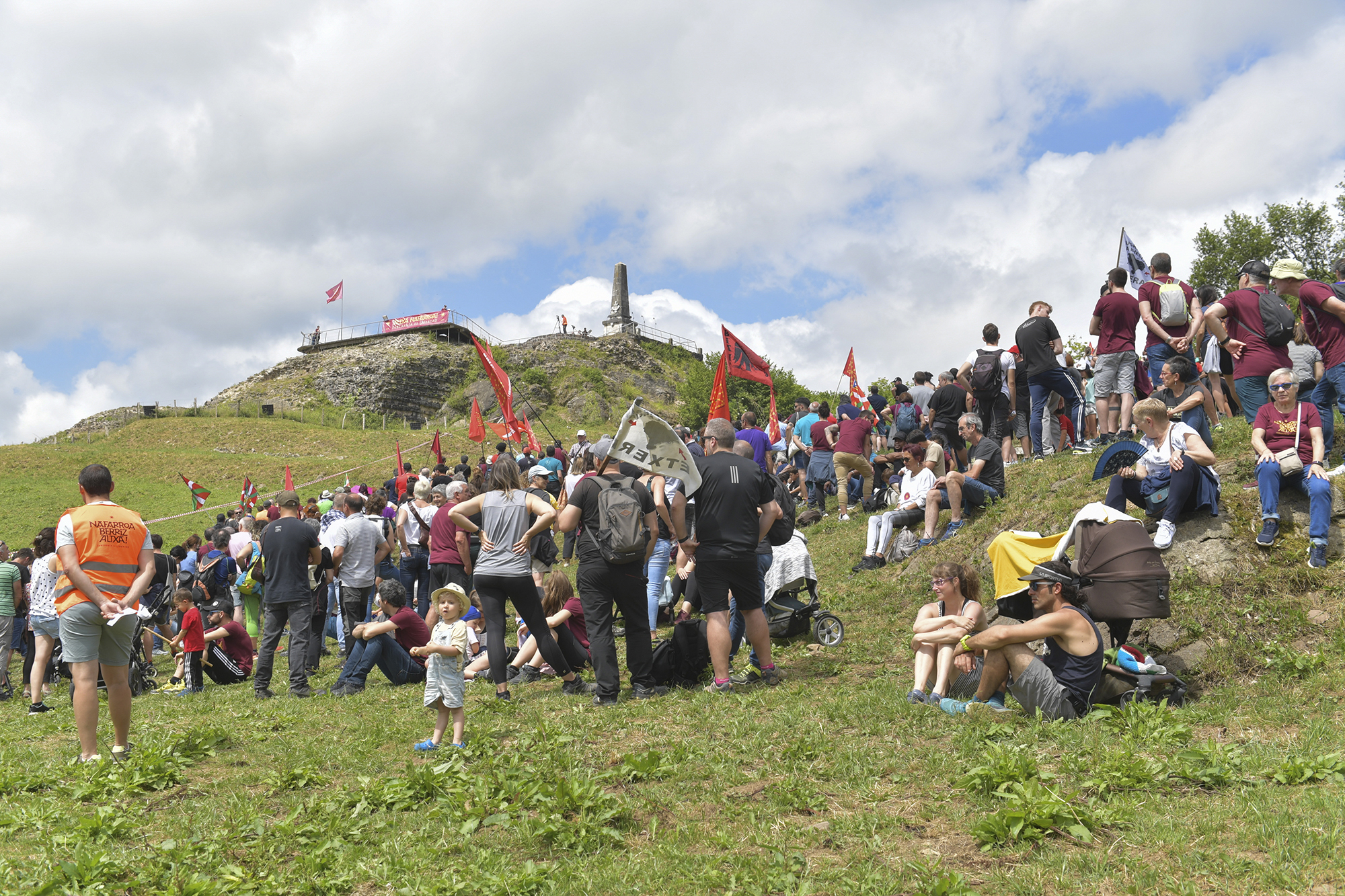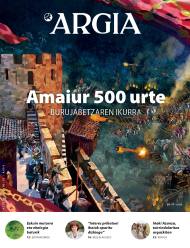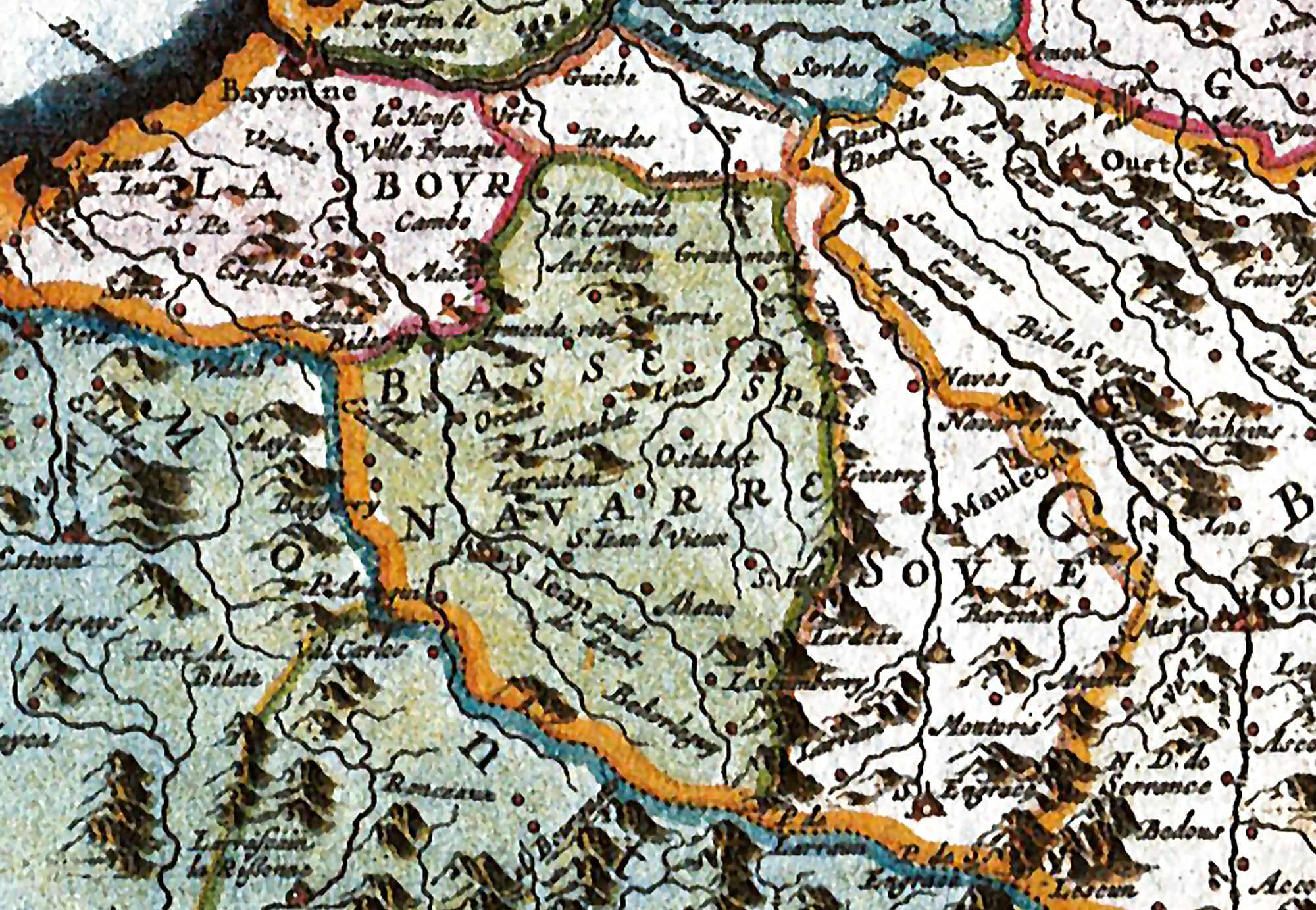Amaiur, recreation of a symbol
- On July 19, 1522, the Spanish army conquered the castle of Amaiur, defeating the Navarran warriors who wanted to resist in defense of their kingdom. It was not the fundamental battle of the conquest of Navarra, nor probably the most symbolic. The cry of the “last Navarros”, five centuries later, is seen as a claim for sovereignty after the silence of the stories.

This year is 500 years since the defenders of the kingdom of Navarra of Amaiur were fortified in his castle and faced the Spanish army. They say it was about two hundred, today we know it was probably only a hundred, against thousands of soldiers. Many of the survivors were imprisoned and some died under lockdown, including Captain Jaime Belaz Medrano, head of Amaiur Castle. Thus, the Spanish King and Emperor Charles V would definitely crush the Navarros’ yearnings for independence.
The battle of Amaiur was perhaps not the most important battle of the conquest of Navarre, for example with the battle of Noáin a year earlier, but it had enormous symbolic value, due to the strategic position of the castle and the wound that the event left among the losers. When in 1841 the outlaws and the kingdom were completely lost, the resistance of the “last Navarros” of Amaiur was recalled and a whole imaginary was built, especially when a century ago nationalism built a monolith to pay tribute to those who fought “for freedom in Navarre”.
The king of Spain ordered in August 1522 the demolition of the castle, “without leaving the stone on the stone”
The 1522 battle has today become a symbol of sovereignty, as we saw in Amaiuraldia on 5 June: hundreds of people gathered in Amaiur and Elizondo to “sculpt that date” in the memory of the people. But what do we know about what really happened? Although historical and archaeological research gives us more and more data, the steam of the epic still covers Amaiur.
Global Plaza of the Empire
When the representative of the viceroy stood before the walls, he asked those inside, on behalf of the emperor. But Jaime Belaz Medrano and the lords of the Navarro king who accompanied him, including Xabier, Aginaga, Azkona and Sada, did not give in. In that castle there were eleven previous fights that were not ready to leave the square without more. It was July 12, 1522 and seven days later the Spaniards ended the brutal assault.
Since the Duke of Alba invaded Navarre ten years earlier, Amaiur changed hands on several occasions: In 1512 it was conquered by Navarre and French troops; in 1513 it was recruited by Captain Frances Beaumont of Arazuri for the invaders; and in 1521, after maintaining the first offensive of the Navarros, in autumn Anton Alguacil, the alleged Castilian warden, had to surrender. Throughout this time, Amaiur became increasingly important.
Because being in the strategic step of the Pyrenees, we wanted to prepare ourselves to face the great and modern artillery-based armies.
We cannot forget what the context was. At Amaiur gogogoan, organized by Nabarralde and Hernani Errotzen, historian Idoia Arrieta highlighted the centralization of monarchies and their connection with the “ideal of a universal empire”. In 1522 Juan Sebastián Elcano turned around the world: “Elkano made direct contact with this world tour of colonialism, imperialism, mass slavery and capitalism.” The interest in controlling the castle of a small Pyrenean valley was therefore often more global than believed.
.jpg)
“We will all die with him to defend the castle”
But what was the situation of the defenders? How did they become besieged in that fortress? Noain’s defeat in 1521 was a great blow to all those who wanted to recover the kingdom of Navarre and Henry II.arentzat. Taking advantage of the confusion caused by the uprising of the villagers in Castile and with the help of the king of France, the occupants were initially sent to the Ebro border.
The answer was immediate and, as we know, French and Navarre troops were defeated in Noáin. However, French admiral Bonnivet began the counterattack in the fall of that year, causing Amaiur to stand in favor of the Navarros, along with Hondarribia. Therefore, from October 3, 1521, we found the castle in charge of Belaz Medrano.
At the time when winter crude was war-conditioned, there was a strange wait for several months. Belaz Medrano did not trust the beaumoneses he sent in Baztán and in Malerreka, including Mr de Urtsua, and so he asked the French for help – seeing that Henry II.ak could not guarantee sufficient resources. “But it wasn’t free,” says historian Peio Monteano Amaiur 1522. Navarroak defendatuko dute (Amaiur 1522. The Navarros who defended the kingdom in his book Mintzoa 2018): “He had to travel to Baiona and offer loyalty to the king of France.”
.jpg)
Since the spring there have been numerous clashes with the imperial troops encamped in Doneztebe. On this occasion, on 30 June the French will go back in San Marcial de Irun to Hondarribia, leaving the defenders of Amaiur unprotected from the rear. That is when the count of Miranda, the viceroy of Navarre, launches to assault them with thousands of soldiers.
They could flee, but at some point we don't know when, Belaz Medrano and the other Navarros lords and warriors will decide to stay in the castle: “We will all die with him to defend the castle,” writes the notary of Etxalar to the abbot of Urdazubi… “He” is, of course, Belaz Medrano. It will include both history books and epic literature, as Lauaxeta in the poem Gaztelu baltza:
There's an ikurrina -- kate ta
lili -- in the tower.
He will sell it on
this mountain or jayo.
Artillery from the sky, explosives underground
Back to 12 July 1522. It seems that by then there was a change in the garrison of Amaiur, in which the Navarros will remain mostly. The last person entered the castle that day, with more weapons and supplies. Everyone thought of what happened a year earlier at Donibane Garazi Castle: the Spaniards threw the defenders from the wall and killed Captain Joanikot Arberoa dismembered in Pamplona.
According to Monteano, the first attack was for Spanish pedestrians and knights the following day, putting stairs on the wall, but the men of Belaz Medrano made them back with great teson, as chronicles and witnesses claim. Subsequently, artillery began to be used continuously. At first it seemed that the castle was going to resist, the assailants suffered many injuries – the viceroy itself was torn with a stone – and the large Castilian cannons were frightened, and more troops were about to arrive by Enrique II.aren, across the Pyrenees to help the Amaiur Navarros.
It is demonstrated that the initiative and the weight of the attack was taken by the viceroy and its Spanish troops, and that almost all the warriors inside were Navarros, in the fight for the king of Navarra Enrique II
Then, the Count of Miranda decided to build a tunnel under the castle and crack it with a mine, a cylindrical wall that was causing so many headaches – paradoxically constructed by the Spaniards in previous years when they had occupied that place. On 19 July the front broke out and the open section was so large that the lords inside had no choice but to draw the white flag, many dead, many wounded, and all of them exhausted their fighting.
Extreme need for farmers and women
What we know about the battle of Amaiur can only be right from a few chronicles and from the archival documents of the time. Historians still have many questions and doubts. For example, how many and who were the aggressors? In 2015, the debate between Pedro Esarte and Peio Monteano was interesting in Diario de Noticias. According to the first, 6,200 regular Castilian soldiers participated in the attack, along with the children of 360 aitas on the guard of the Count of Miranda, and among the aggressors the Navarros warriors were only a few. In contrast, Monteano said that the Castellanos did not have more than 1,500 pedestrians and 600 horsemen, while the Navarros were 2,500, probably “against their will”.
In any case, it is well established that the initiative and the weight of the attack was taken by the viceroy and its Spanish troops, and that almost all the warriors inside were Navarros, in the fight for the king of Navarra Enrique II. Another thing is what happened to the citizens, which we know much less about.
For example, when in 1513 the conquerors began the fortification works of the castle of Amaiur, many women participated. They transported stones, wood and gravel to build their prey and also worked on the destruction of the castle after the battle of 1522. According to the guestbook of Aranzadi and the Castle of Amaiur Society to the Archaeological Center of Amaiur, the documentation includes at least 70 names of Amaiurtarras women who help the quarries: Maria el Fuerte, Graciana Irigoien, Katherina Arretxe, Johana Pezoinarte… “However, her salary was lower than that of men,” can be read in the leaflet. Precisely, Asisko Urmeneta is based on the march of one of them, Amaiur! Liberate State (Erroa, 2022) in his comic book.
Violence against citizens, such as that employed by the count of Miranda to feed his army, was not small. Despite the extreme need after the bad harvests of previous years, one of the reasons why Mr de Asparrots lost the Battle of Noain, many were seized by carriages and animals to arrest those who, even in the most remote regions, refused to comply by sending soldiers. According to Esarte, the Spaniards obtained supplies at Olite, Tafalla, Sangüesa, Estella, etc. and transported them with the help of the Count of Lerín, Luis Beaumont, on the board of Belate to Amaiur.
.jpg)
Penalty losers and destination
As soon as the white flag was received in the castle of Amaiur, almost all those inside were imprisoned in exchange for respect for life, including the lords who led the struggle: Miguel de Javier, brother of Francisco; Víctor Mauleo and his brother Luis; Juan Oiloki; Juan Azpilkueta; and Jaime Belaz Medrano and his son.
On 23 July they were transferred to Pamplona and locked in the castle of Santiago. It seems that the viceroy was concerned about the “safety” of the prisoners, others again demanded the rescue, there was even some attempted escape with tip to the guards… However, after a month Belaz Medrano and his son were killed in the hot yet unresolved event. His memory has been absorbed by history to this day. The castle also had no better destination. Emperor Charles V ordered his demolition “without leaving the stone on the stone”, and they did so: on 11 August there was a huge explosion throughout the Baztan, provoked by explosives willing to kill Amaiur forever.
The interest in controlling the castle of a small Pyrenean valley was often more global than thought
José María Jimeno Jurio wrote that the history of Amaiur did not end in 1522, which later structured the social physiognomy of the people, but the Navarros who defended the castle “took the victors as traitors”. We do not see in vain dozens of people excluded from the forgiveness given to him by the king of Spain a year later, “for rebelling against his homeland”. Sanction and experience.
After Noáin and Amaiur, faced with the difficulty of “correcting” the situation, researcher María Puy Huici, in her critical book on conquest, affirmed that both beaumonesa and agaramontesa, had begun to defend their interests and power, but that many still thought that the conquest was not irreversible, including the Spanish monarchs: “The emperor himself questioned the legitimacy of the conquest.” Perhaps that is how we can better understand why, until now, this symbol of our history has been buried, just in case, until the work of the local community has emerged.
.jpg)
Amaiurko 1522ko gertaera “ikur historiografiko bezala nahiko garaikidea da”, azaldu du Xabier Irujo historialariak Hernaniko Amaiur gogoan jardunaldietarako Youtuben paratutako bideoan: “Nafarroak erreinu izateari utzi zionean 1841ean –eta bigarren karlistaldiaren ondoren 1876an– Amaiur erresistentziaren ikur bilakatzen da”.
Juan Iturralde y Suit idazle eta margolari iruindarra izan zen lehenengotakoa Amaiur aldarrikatzen XIX. mendean, berak sortutako Nafarroako Euskal Elkargoaren bidez, eta 1922an lehen obeliskoa inauguratu zen –besteak beste Julio Altadill eta Arturo Campionen bultzadaz–, borrokaldiaren 400. urtemugan. Baina 1931n errepublika ezarri eta gutxira eskuindarren atentatu batek deuseztatu zuen monumentua eta ez zen 1982ra arte berregin. “Bitarte horretan, abertzaletasunak Amaiurren atzean zegoen historia garatu eta bere egin zuen”, dio Irujok.
.jpg)
Geroztik, 1936ko Gerrako batailoiak, ETAko komandoak, aldizkariak eta koalizio politikoak sortu izan dira izen horrekin, besteak beste.
Nafarroa Berriz Altxa: “500 urte geroago hemen gaude zutik”
Gaur egunera etorrita, subiranotasunaren aldeko mugimenduaren topagune bihurtu da Amaiur. Nafarroa Berriz Altxa ekimenak ekainaren 5ean egindako Amaiuraldia-n esan zuen 500 urte pasa izanagatik, “gaurkotasun” handiko aldarrikapena dela, “egunerokotasunean eragina duten erabakiak non eta nork hartzen dituen” gakoa baita euren ustez.
“Zer eta nola kontsumitu behar dugun baldintzatzen dute –azaldu zuten Amagoia Susperregik eta Eneko Compainsek gaztelua dagoen tontorretik, ehunka lagunen aurrean–, lan harreman markoa edo gure gastu aurrekontuek izan behar duten gastu sabaia arautu… Hemen libreki hartzen ez diren erabakiek, nafarrek krisi ezberdinei ematen dizkiegun erantzunak baldintzatzen dituzte: krisi klimatikoa, elikadura, energia edo migrazio krisiei, esaterako”.

Amaiurko 1522ko gertaeren protagonista nagusiena, Iguzkitzako familiaren dorretxean jaio zen 1475 urte inguruan. Bere leinuak nafar erregeekin zein agaramontar familiekin zituen loturen ondorioz, 1512an erresistentzia antolatzen ibiliko da Pedro Nafarroakoa mariskalaren ondoan.
Ondoren, konkistatzaileen kontrako altxaldi guztietan ikusiko dugu lehen lerroan: 1513an, 1516an eta 1521ean. Amaiurren bere burua entregatu zuen, seguruenik erreskate bidez libre geratu eta beste altxaldi bat antolatzeko itxaropenarekin. Baina Iruñeko ziegatan hil zuten; nola ez dakigu.
Oinordekoek ez zuten orduz geroztik Jaime Belaz Medrano eta Etxauzen aipamenik egin eta bere izena eta historia oharkabean igaro da askorentzat.
1095
Amaiur edo Maier dokumentuetan agertzen da lehen aldiz, Baionako katedralari egindako dohaintza batean.
1266
Bidesariei loturiko lehen erreferentzia. Halako gazteluak muinoetan kokatzen ziren, eta funtzio militarra izateaz gain, merkataritza kontrolatzeko ere erabiltzen ziren.
1389
Amaiurko gazteluko bost dorreak egoera kaskarrean zeudela adierazi zuen obra maisu batek.
1452
Joan II.aren eta bere seme Vianako Printzearen arteko gatazketan –agaramontar eta beaumondarrak– gazteluari eraso egin zioten.
1512
Nafarroako konkistarekin, gaztelarren esku geratuko da. Hurrengo urteetan “trantsizioko gotorleku” bilakatu zuten, kubo erdizirkular, uharka eta horma lodi berriekin, artilleriaren erasoari aurre egiteko.
1521
Nafar erregearen aldeko tropek gaztelua berreskuratu zuten eta Jaime Belaz Medrano jarri zen defentsaren buru.
1522
Amaiurko borroka eta suntsipena. Defendatzaileak preso hartu eta hiru astera, gotorlekua zimenduak eta guzti leherrarazi zuten. Harrobi bezala erabiliko da eliza, etxeak eta hesiak eraikitzeko harriak lortzeko.
1637
Europako Hogeita Hamar Urteko Gerraren testuinguruan gotorleku berria eraikitzen hasiko dira, baina handik hiru urtera lanak bertan behera utzi zituzten.
1794
Gazteluaren muinoan zegoen ermita aprobetxatuz, Konbentzioaren Gerran behin-behineko gotorleku bat eraiki zuten, baina frantziarrek suntsitu zuten ondoren.
2006
Amaiurko herriak eta Baztango Udalak indusketak hasi zituzten auzolanean, Aranzadi Zientzia elkarteak gidatuta. Gazteluko zati garrantzitsuak azalerazi dituzte eta aztarna ugari jaso ( XV. mendeko ezpata bat, kanoi bolak…); gainera, ingurua museo bihurtu dute.
2010
Aitor Pescador Aranzadiko kideak ordainagiri baten bidez frogatu zuen Amaiurko gazteluko atea Arraiozko Jauregizarreko bera dela, Urtsuako jaunari opari bezala emana 1522an.
2020
Amaiurren Arkeologia Zentroa ireki zuten gazteluari eta herriari buruzko informazioarekin.
Immersed in the war against the community lords and churches, in 1521, Castile obtained the help of his brother-in-law Enrique de Navarra II.ak, King Francisco I of France, to recover the kingdom of Navarre invaded, conquered and occupied nine years earlier.
Parents Enrike... [+]
Memoria eta aldarrikapen eguna izan da larunbatean Amikuzeko hiriburuan. "Sekulan baino gehiago, gure izanetik aurkitu indarraz, bihar gu girena hazi", izan dira Zabalik elkarteko presidentearen hitzak, Nafarroa Bizirik eguneko ekitaldi ofizialean.
The ideological heirs of the conquerors of the Kingdom of Navarra are today the political parties that manage means such as patriarchal intellectual production and EITB. These heirs continue with the colonization process of Navarre, distorting historical contexts and negating... [+]
The castle of Amaiur (1522), in Baztán, was the last strength of the resistance against the Spanish conquest of the Kingdom of Navarra. The rebels, with their courage, also dominated the kingdom of Spain, challenged by their hearts, sought to rise up against the... [+]
You will easily see Spaniards of a certain age who want to underestimate or reduce the severity of something: “More was lost in Cuba,” recalling the loss of the remains of the colonial empire in 1898. Hungarians also have a similar expression, which is used in the same sense... [+]



















